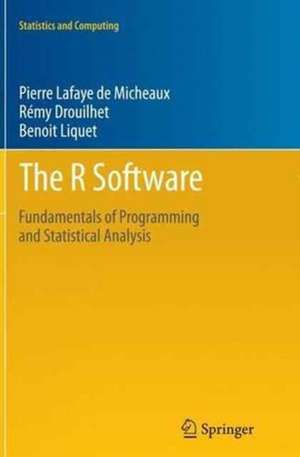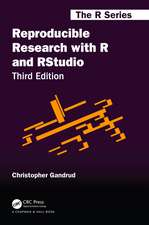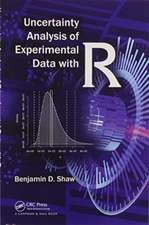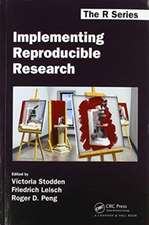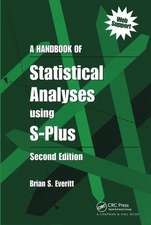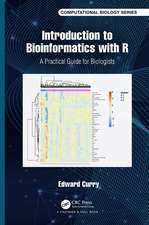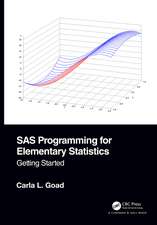The R Software: Fundamentals of Programming and Statistical Analysis: Statistics and Computing, cartea 40
Autor Pierre Lafaye de Micheaux, Rémy Drouilhet, Benoit Liqueten Limba Engleză Paperback – oct 2016
| Toate formatele și edițiile | Preț | Express |
|---|---|---|
| Paperback (1) | 864.98 lei 38-45 zile | |
| Springer – oct 2016 | 864.98 lei 38-45 zile | |
| Hardback (1) | 882.54 lei 38-45 zile | |
| Springer – 28 feb 2014 | 882.54 lei 38-45 zile |
Din seria Statistics and Computing
- 20%
 Preț: 753.99 lei
Preț: 753.99 lei -
 Preț: 228.21 lei
Preț: 228.21 lei - 20%
 Preț: 505.20 lei
Preț: 505.20 lei -
 Preț: 438.82 lei
Preț: 438.82 lei -
 Preț: 386.81 lei
Preț: 386.81 lei - 20%
 Preț: 1059.77 lei
Preț: 1059.77 lei -
 Preț: 426.73 lei
Preț: 426.73 lei - 20%
 Preț: 474.37 lei
Preț: 474.37 lei - 18%
 Preț: 1387.07 lei
Preț: 1387.07 lei -
 Preț: 433.53 lei
Preț: 433.53 lei -
 Preț: 208.58 lei
Preț: 208.58 lei - 20%
 Preț: 1174.26 lei
Preț: 1174.26 lei - 18%
 Preț: 959.32 lei
Preț: 959.32 lei - 15%
 Preț: 643.48 lei
Preț: 643.48 lei -
 Preț: 392.75 lei
Preț: 392.75 lei -
 Preț: 404.29 lei
Preț: 404.29 lei - 15%
 Preț: 640.06 lei
Preț: 640.06 lei - 20%
 Preț: 1454.73 lei
Preț: 1454.73 lei -
 Preț: 377.18 lei
Preț: 377.18 lei - 23%
 Preț: 652.31 lei
Preț: 652.31 lei - 15%
 Preț: 710.42 lei
Preț: 710.42 lei - 15%
 Preț: 695.85 lei
Preț: 695.85 lei - 20%
 Preț: 1276.86 lei
Preț: 1276.86 lei - 18%
 Preț: 1003.38 lei
Preț: 1003.38 lei - 15%
 Preț: 703.85 lei
Preț: 703.85 lei -
 Preț: 384.70 lei
Preț: 384.70 lei - 15%
 Preț: 606.17 lei
Preț: 606.17 lei - 15%
 Preț: 646.94 lei
Preț: 646.94 lei - 15%
 Preț: 589.02 lei
Preț: 589.02 lei - 18%
 Preț: 1117.99 lei
Preț: 1117.99 lei -
 Preț: 503.52 lei
Preț: 503.52 lei - 18%
 Preț: 735.38 lei
Preț: 735.38 lei - 15%
 Preț: 693.90 lei
Preț: 693.90 lei
Preț: 864.98 lei
Preț vechi: 1138.14 lei
-24% Nou
Puncte Express: 1297
Preț estimativ în valută:
165.52€ • 176.99$ • 138.00£
165.52€ • 176.99$ • 138.00£
Carte tipărită la comandă
Livrare economică 14-21 aprilie
Preluare comenzi: 021 569.72.76
Specificații
ISBN-13: 9781493941438
ISBN-10: 1493941437
Pagini: 665
Ilustrații: XXXVII, 628 p. 50 illus., 41 illus. in color.
Dimensiuni: 155 x 235 mm
Ediția:Softcover reprint of the original 1st ed. 2013
Editura: Springer
Colecția Springer
Seria Statistics and Computing
Locul publicării:New York, NY, United States
ISBN-10: 1493941437
Pagini: 665
Ilustrații: XXXVII, 628 p. 50 illus., 41 illus. in color.
Dimensiuni: 155 x 235 mm
Ediția:Softcover reprint of the original 1st ed. 2013
Editura: Springer
Colecția Springer
Seria Statistics and Computing
Locul publicării:New York, NY, United States
Cuprins
Foreward.- Basic Concepts and Data Organisation.- Importing, Exporting and Producing Data.- Data Manipulation, Functions.- R and its Documentation.- Drawing Curves and Plots.- Programming in R.- Managing Sessions.- Basic Mathematics.- Descriptive Statistics.- A Better Understanding of Random Variables.- Confidence Intervals and Hypothesis Testing.- Simple and Multiple Linear Regression.- Elementary Analysis of Variance.- Installing R and R Packages.- References.- Indices.- Solutions.
Recenzii
From the book reviews:
“This is a great addition to the chorus of books on R. It is a clear an excellent resource for teaching courses on data analysis and statistical computing using R at the graduate and advanced undergraduate levels. The book can be an asset for data scientists, and even more broadly for a wide variety of users including students, teachers, researchers, software engineers, and others whose work involves statistics, mathematics, and computer science.” (Yousri El Fattah, Computing Reviews, January, 2015)
“This is a great addition to the chorus of books on R. It is a clear an excellent resource for teaching courses on data analysis and statistical computing using R at the graduate and advanced undergraduate levels. The book can be an asset for data scientists, and even more broadly for a wide variety of users including students, teachers, researchers, software engineers, and others whose work involves statistics, mathematics, and computer science.” (Yousri El Fattah, Computing Reviews, January, 2015)
Notă biografică
Pierre Lafaye de Micheaux is a Canadian-French-Swiss researcher, Adjunct Associate Professor at Université de Montréal (Canada) and Associate Professor at Grenoble University (France). In 2013-14, he is a Senior Visiting Fellow to the Department of Statistics and also to the School of Psychiatry of the University of New South Wales (Sydney, Australia). His main research interests are: Asymptotics, Biostatistics, Bootstrap, Complex random variables, Developing R packages, Hypothesis testing theory, Independent Component Analysis, Multiple testing and Sample size determination, Multivariate statistics, Neuroscience, Reproducible research, Time series analysis. Pierre is an experienced user of Linux and R since 1998 and the co-author of several R packages available on the CRAN.
Rémy Drouilhet is a lecturer at Grenoble University, Pierre Mendès France. He has worked on the spectral behavior of fractional Brownian motion, and particularly on the estimation of its spectral density. Rémy has contributed to spatial point processes through the research group he formed with Jean Michel Billot and Etienne Bertin. Over the 7 years of their intense collaboration, they have obtained many results concerning existence, unicity and percolation in the framework of spatial point processes based on nearest neighbor interactions. Rémy now works with the FIGAL team on issues of reliability. He is an experienced user and developer of R which he uses both in his research and in his teaching.
Benoit Liquet obtained his PhD in Biostatistics and his research first focused on model selection approach applied to biomedical studies. He has researched and taught at INSERM (French National Institute of Health) and the Universities of Montpellier and Bordeaux. Recently, Benoit has worked on the analysis of omics data in the context of HIV vaccine studies. He spent six months (during his sabbatical leave in 2011/2012) working full time at the Queensland Facility for Advanced Bioinformatics (QFAB), based at the University of Queensland, to develop novel methodologies within this context. Benoit finished his sabbatical leave in the MRC (medical research council) BSU (Biostatistics Unit) in Cambridge on Bayesian variable selection methods for high dimensional data. He is presently working as Senior Investigator Statistician at the MRC BSU. He is an enthusiastic user and developer of R.
Rémy Drouilhet is a lecturer at Grenoble University, Pierre Mendès France. He has worked on the spectral behavior of fractional Brownian motion, and particularly on the estimation of its spectral density. Rémy has contributed to spatial point processes through the research group he formed with Jean Michel Billot and Etienne Bertin. Over the 7 years of their intense collaboration, they have obtained many results concerning existence, unicity and percolation in the framework of spatial point processes based on nearest neighbor interactions. Rémy now works with the FIGAL team on issues of reliability. He is an experienced user and developer of R which he uses both in his research and in his teaching.
Benoit Liquet obtained his PhD in Biostatistics and his research first focused on model selection approach applied to biomedical studies. He has researched and taught at INSERM (French National Institute of Health) and the Universities of Montpellier and Bordeaux. Recently, Benoit has worked on the analysis of omics data in the context of HIV vaccine studies. He spent six months (during his sabbatical leave in 2011/2012) working full time at the Queensland Facility for Advanced Bioinformatics (QFAB), based at the University of Queensland, to develop novel methodologies within this context. Benoit finished his sabbatical leave in the MRC (medical research council) BSU (Biostatistics Unit) in Cambridge on Bayesian variable selection methods for high dimensional data. He is presently working as Senior Investigator Statistician at the MRC BSU. He is an enthusiastic user and developer of R.
Textul de pe ultima copertă
The contents of The R Software are presented so as to be both comprehensive and easy for the reader to use. Besides its application as a self-learning text, this book can support lectures on R at any level from beginner to advanced. This book can serve as a textbook on R for beginners as well as more advanced users, working on Windows, MacOs or Linux OSes. The first part of the book deals with the heart of the R language and its fundamental concepts, including data organization, import and export, various manipulations, documentation, plots, programming and maintenance. The last chapter in this part deals with oriented object programming as well as interfacing R with C/C++ or Fortran, and contains a section on debugging techniques. This is followed by the second part of the book, which provides detailed explanations on how to perform many standard statistical analyses, mainly in the Biostatistics field. Topics from mathematical and statistical settings that are included arematrix operations, integration, optimization, descriptive statistics, simulations, confidence intervals and hypothesis testing, simple and multiple linear regression, and analysis of variance. Each statistical chapter in the second part relies on one or more real biomedical data sets, kindly made available by the Bordeaux School of Public Health (Institut de Santé Publique, d'Épidémiologie et de Développement - ISPED) and described at the beginning of the book. Each chapter ends with an assessment section: memorandum of most important terms, followed by a section of theoretical exercises (to be done on paper), which can be used as questions for a test. Moreover, worksheets enable the reader to check his new abilities in R. Solutions to all exercises and worksheets are included in this book.
Caracteristici
Comprehensive textbook on the R language Authors have completed extensive research & use of R in Biostatistics, Economics & Statistical theory & methods Features simulation approach to several key concepts of statistical analysis Includes supplementary material: sn.pub/extras
